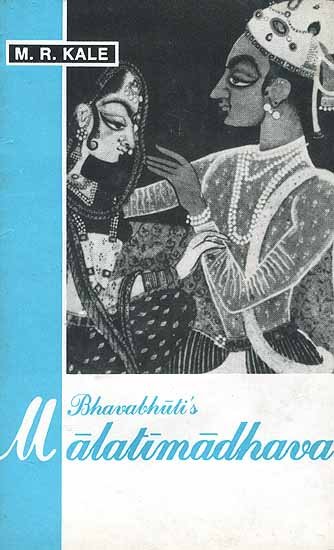Malatimadhava (study)
by Jintu Moni Dutta | 2017 | 52,468 words | ISBN-10: 8120813057 | ISBN-13: 9788120813052
This page relates ‚ÄėVarious Customs and Rituals of Marriage‚Äô from the English study on the Malatimadhava of Bhavabhuti:‚ÄĒA Prakarana type of Drama in ten acts revolving around the love-story of Malati (from PadmńĀvatńę) and Madhava (from Vidarbha). This study discusses the history of its author and the literary, social, religious, historical and cultural aspects of the Malatimadhava.
Part 2.4 - Various Customs and Rituals of Marriage
In Hindu marriage, various customs had been followed and rituals had been performed since the ancient time by the people of Indian society. In the MńĀlatńęmńĀdhava also BhavabhŇęti has given a detailed account of the social customs pertaining to marriage ritual during his time. There was a dangerous custom in BhavabhŇęti‚Äôs time. In those days parents used to give the marriage proposal before the birth of their child. They took oath to join their children in wedlock. In the 1stact it is found that BhŇęrivasu and DevarńĀta were two best friends when they were students and they made solemn declaration in the presence of SaudńĀminńę to join their offsprings in wedlock.[1] In the 10th act SaudńĀminńę discloses it that the cherished object of the ministers, BhŇęrivasu and DevarńĀta, regarding the alliance of their children, has been accomplished in the long run.[2]
In the 6th act, it is observed that on the day of MńĀlatńę‚Äôs marriage ceremony everyone made haste for the welcome of bridegroom‚Äôs party where hundreds of door-keepers were found busy with preparations for the marriage. [3] Again, it is known from the speech of Makaranda that the sound of thousands of deep auspicious drums had been arisen during the time of MńĀlatńę‚Äôs marriage.The sound of thousands of deep-sounding auspicious drums resembled the peal of a train of clouds scattered by the wind and deprived Makaranda and MńĀdhava the power of hearing any other sound.[4] This speech clearly shows that various types of musical instruments were used during the marriage in BhavabhŇęti‚Äôs time. There is another custom where it is found that the bride should be decorated before the deity. MńĀlatńę‚Äôs bridal dress was presented by the king through a door‚Äďkeeper with the saying that MńĀlatńę should be decorated before the deity.[5] The bridal dress included a bodice of white silk and red silk garment to serve the purpose of the mantle and sets of ornaments suitable for all parts of the body and necklace of pearls, sandal paste and a garland of white flowers.[6] Hence, it proves that during BhavabhŇęti‚Äôs time also the custom of giving the bridal dress from the side of bridegroom was in vogue. The Atharvaveda refers to giving away of the garment to the bride. [7] This Veda also refers to wearing a new garment by bride.[8]
It has been also found that on the way of MńĀlatńę‚Äôs going to temple the female elephants appeared clanking with the sound of the collections of golden bells. These were tinkling and mounted by bevies of courtesans that were giving rise to a confused noise by singing aloud the sweet auspicious songs. The songs were uttered indistinctly in consequence of the expanse of the orbs of their cheeks being filled with rolls of betel-leaves chewed sportively. They decorated the surface of the sky with the beaming rays of various jewel ornaments resembling the fragments of Indra‚Äôs bow[9]. This description apparently shows that women took part actively in the occasion of marriage ceremony and they enjoyed the marriage festival happily.
Like the customs, various rituals were also found in the marriage ceremony during the time of BhavabhŇęti. In the 6th act it is found that BrńĀhmaŠĻáas had recited sacred mantras for auspicious purpose of MńĀlatńę‚Äôs marriage ceremony followed by various songs.[10] Again, MńĀlatńę was ordered by her mother to go to the temple of deity in order to ward off the obstacles from the auspicious marriage ceremony and to attain good fortune.[11] It was customary also among the people during 8th century A.D. for the intended bride to pay her adoration to some divinity before her marriage. In the Atharvaveda also worship of different gods on the eve of the marriage is found. [12]
Another ritual mentioned by BhavabhŇęti in the MńĀlatńęmńĀdhava is the entrance of bride‚Äôs new home after the completion of actual marriage ceremony. In the 7th act it was found that the servants were busy in taking part in the great untimely Kaumudńę festival staged for the new bride at the mansion of Nandana.[13] This ritual apparently indicates the rite of gŠĻõhapraveŇõa performed by the people of 8th century A.D.
Thus, BhavabhŇęti has depicted the various customary practices in respect of marriage observed by people during the period of 8th century A.D. It has appeared that society strictly followed the rules of marriage that ordained in the smŠĻõtis and gŠĻõhyasŇętras.
Footnotes and references:
[1]:
tadeva cńĀsmatsaudńĀminńęsamakŠĻ£amanayorbhŇęrivasudevarńĀtayorvŠĻõtteyaŠĻÉ pratij√ĪńĀavaŇõyamńĀvńĀbhyńĀmapatyasambandhaŠł• kartavya iti /
Ibid.,I.p.14
[2]:
idamatra ramaŠĻáńęataraŠĻÉ yadamńĀtyorbhŇęrivasudevarńĀtayoŇõcirńĀtpŇęr
ŠĻáo‚ÄüayamitaretarńĀpatyasaŠĻÉvandhńĀtmńĀ manorathaŠł• //
Ibid.,X.p.216
[3]:
pratyńĀsannastvarayatitarńĀŠĻÉjanyayńĀtrńĀpraveŇõaŠł• Ibid.,VI.2 mńĀlatńęvivńĀhaparikarmasatvarapratńęhńĀraŇõataŇõaŠĻÉkulńĀpradeŇõńĀdapakramya mńĀdhavńĀpakńĀraŠĻÉ pratyabhiniviŠĻ£ŠĻ≠ńĀ bhavńĀmi /
Ibid.,VI.p.120
[4]:
asmńĀkamekapada eva marudvikńęrŠĻáa /
jńęmŇętajńĀlarasitńĀnukŠĻõtirninńĀdaŠł• //
gambhńęramaŠĻÖgalamŠĻõdaŠĻÖgasahasrajanmńĀ /
ŇõabdńĀntaragrahaŠĻáaŇõaktimapńĀkaroti //
Ibid.,VI. 4
[5]:
pratihńĀrńę -bhagavatńę amńĀtyo bhaŠĻáati etena narendrńĀnupreŠĻ£itena vivńĀha nepathyena devatńĀ puratoalaŠĻÉkartavyńĀ mńĀlatńęti /
Ibid.,VI.p.125
[6]:
etattńĀvatdhavalapaŠĻ≠ŠĻ≠ńĀŠĻÉŇõuka colakametaccottarńęyaŠĻÉ raktavarŠĻáńĀŠĻÉŇõukam /
ime sarvńĀŠĻÖgikńĀ ńĀbharaŠĻá saŠĻÉyogńĀŠł• /
Ibid.
[7]:
Atharvaveda, XIV.II.41 -42, 48-49
[8]:
Ibid., XIV.,II.51
[9]:
imńĀŠł•savilńĀsakavalitatńĀmbulavńęŠĻ≠ikńĀpŇęritakapolamaŠĻኳćalńĀbhogavyatikaraskhalitama dhuramaŠĻÖgalodgńętavadhakolńĀhalairvividharatnńĀlaŠĻÉkńĀrakiraŠĻáńĀvalńęviŠłćamvbita mahendracńĀpavichedavichuritanabhaŠł•sthalairvńĀrasundarńękadambairadhyńĀsitńĀ utkvaŠĻáatkanakakiŠĻÉkiŠĻáńęjńĀlajanjaŠĻÉkńĀriŠĻáyakariŠĻáyaŠł• //
MńĀlatńęmńĀdhava,VI.p.122
[10]:
kartavyeŠĻ£u ŇõravaŠĻáasubhagaŠĻÉ bhŇęmidevńĀŠł• paŠĻ≠hantu /
citraŠĻÉ nńĀńĀvacananivahaiŇõceŠĻ£ŠĻ≠ayatńĀŠĻÉ maŠĻÖgaleb hyaŠł• //
Ibid., VI.2
[11]:
sakhi asminpńĀŠĻáigrahaŠĻáamaŠĻÖgalńĀrambhe kalyńĀŠĻáasaŠĻÉpattinimittaŠĻÉ devatńĀŠł• pŇęjayetyamb ayńĀnupreŠĻ£itńĀsi //
Ibid.,VI.p.127
[12]:
Atharvaveda,XIV.I.50-54
